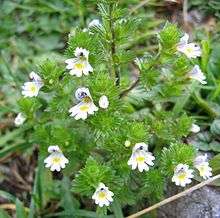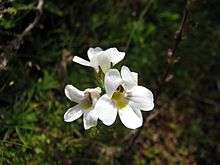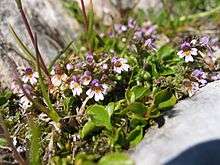Euphrasia
| Euphrasia | |
|---|---|
 | |
| Euphrasia rostkoviana | |
| Scientific classification | |
| Kingdom: | Plantae |
| (unranked): | Angiosperms |
| (unranked): | Eudicots |
| (unranked): | Asterids |
| Order: | Lamiales |
| Family: | Orobanchaceae |
| Tribe: | Rhinantheae |
| Genus: | Euphrasia |
| Species | |
|
About 450, see text | |
Euphrasia (eyebright) is a genus of about 450 species of herbaceous flowering plants in the family Orobanchaceae (formerly included in the Scrophulariaceae), with a cosmopolitan distribution. They are semi-parasitic on grasses and other plants. The common name refers to the plant's use in treating eye infections.
Many species are found in alpine or sub-alpine meadows where snow is common. Flowers usually are borne terminally, are zygomorphic, and have a lower petal shaped like a lip. The most common flower colours are purple, blue-white, and violet. Some species have yellow markings on the lower petal to act as a guide to pollinating insects.
Alternative names, mainly in herbalism, are Augentrostkraut, Euphrasiae herba, Herba Euphrasiae and Herbe d'Euphraise.
Use in herbalism and medicine
The plant was known to classical herbalists, but then was not referred to until mentioned again in 1305. Nicholas Culpeper assigned it to the Zodiac sign Leo, claiming that it strengthened the brain. It was also used to treat bad memory and vertigo.[1]
In the Elizabethan era the plant was used in ales and Gervase Markham's Countrie Farm (1616) recommended that one should "Drinke everie morning a small draught of Eyebright wine."[2]
Herbalists use eyebright as a poultice with or without concurrent administration of a tea for the redness, swelling, and visual disturbances caused by blepharitis and conjunctivitis. The herb is also used for eyestrain and to relieve inflammation caused by colds, coughs, sinus infections, sore throats and hay fever.
Parts used include the leaf, the stem, and small pieces of the flowers. Typical preparations include a warm compress or tea. Eyebright preparations are also available as an extract or capsule.
A report from the European Medicines Agency states about the efficacy of Euphrasia remedies:
From the presence of secondary metabolites, an astringent and anti-inflammatory activity can be hypothesized for Euphrasia preparations. The ocular use of Euphrasia is based upon tradition. However, since the efficacy of the claimed ocular uses is undocumented and external eye application is not hygienic, therapeutic use cannot be recommended.[3]
Phylogeny
The phylogeny of the genera of Rhinantheae has been explored using molecular characters.[4][5] Euphrasia belongs to the core Rhinantheae. Euphrasia is the sister genus to Odontites, Bellardia, Tozzia, and Hedbergia. In turn, these five genera share phylogenetic affinities with Bartsia.
| Cladogram: Genus-level phylogeny of tribe Rhinantheae based on molecular characters (ITS, rps16 intron and trnK region).[4][5] | ||||||||||||||||||||||||||||||||||||||||||||||||||||||
|
|
Taxonomy and identification
The genus Euphrasia is taxonomically complicated due to many species being interfertile and prone to hybridisation. Despite there having been a number of taxonomic revisions[6][7][8] the appropriate rank of many taxa, as well as the relationships between them, remains unclear.
Selected species

|
|
References
- ↑ Howard, Michael (1987): Traditional Folk Remedies. Century. p.136
- ↑ Grieve, Maud (1971). A Modern Herbal: The Medicinal, Culinary, Cosmetic and Economic Properties, Cultivation and Folk-lore of Herbs, Grasses, Fungi, Shrubs, & Trees with All Their Modern Scientific Uses, Volume 1. p. 292. ISBN 9780486227986.
- ↑ "Assessment report on Euphrasia officinalis L. and Euphrasia rostkoviana Hayne, herba (Page 13)" (PDF).
- 1 2 Těšitel, Jakub; Říha, Pavel; Svobodová, Šárka; Malinová, Tamara; Štech, Milan (2010-10-28). "Phylogeny, Life History Evolution and Biogeography of the Rhinanthoid Orobanchaceae". Folia Geobotanica. 45 (4): 347–367. doi:10.1007/s12224-010-9089-y. ISSN 1211-9520.
- 1 2 Scheunert, Agnes; Fleischmann, Andreas; Olano-Marín, Catalina; Bräuchler, Christian; Heubl, Günther (2012-12-14). "Phylogeny of tribe Rhinantheae (Orobanchaceae) with a focus on biogeography, cytology and re-examination of generic concepts". Taxon. 61 (6): 1269–1285.
- ↑ Yeo PF. (1978). "A taxonomic revision of Euphrasia in Europe" Botanical Journal of the Linnean Society 77 (4) 223–334
- ↑ Barker WR.(1982) "Taxonomic Studies in Euphrasia L.(Scrophulariaceae): A Revised Infrageneric Classification, and a Revision of the Genus in Australia" J. Adelaide Bot. Gard. 5: 1-304.
- ↑ Sell PD, Yeo PF. (1970). "A revision of the North American species of Euphrasia L. (Scrophulariaceae)". Botanical Journal of the Linnean Society 63 (3) 189–234,
- ↑ English Names for Korean Native Plants (PDF). Pocheon: Korea National Arboretum. 2015. p. 465. ISBN 978-89-97450-98-5. Archived from the original (PDF) on 25 May 2017. Retrieved 16 December 2016 – via Korea Forest Service.
- ↑ "Assessment report on Euphrasia officinalis L. and Euphrasia rostkoviana Hayne, herba (Page 2,top)" (PDF).
Footnotes
- ↑ Also known as Euphrasia sp. 'fabula'; related to but not identical with E. fabula.
| Wikimedia Commons has media related to Euphrasia. |
